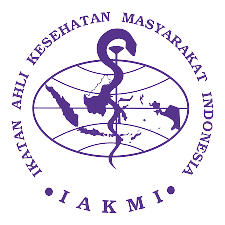RISK FACTORS OF OBESITY IN ADOLESCENCE: A CASE CONTROL STUDY
Abstract
Obesity in adolescents needs attention because it can persist into adulthood and increase the risk of degenerative diseases. In Tasikmalaya district, there has not been much research related to obesity risk factors, including with case control study. This research aims to analyze the risk factors associated with obesity in adolescents. The research sample consists of teenagers from a private school in Tasikmalaya Regency. This study uses a case-control design, with a total of 32 cases (total sampling) and 64 controls, resulting in a total sample of 96 students. The independent variables are junk food consumption, soft drink consumption, vegetable and fruit consumption, physical activity, screen time, and sleep duration. Data collection techniques were conducted through interviews and food recalls, as well as measuring obesity using the BMI indicator. Data analysis employed the chi-square test at a 95% confidence level. The research results indicate that the variables of junk food consumption (p-value=0.025; OR=3.1), soft drink consumption (p-value=0.017; OR=3.3), vegetable consumption (p-value=0.012; OR=3.4), fruit consumption (p-value=0.017; OR=3.2), physical activity (p-value=0.002; OR=4.5), screen time (p-value=0.017; OR=3.2), and sleep duration (p-value=0.035; OR=2.8) have a significant relationship with the incidence of obesity in adolescents. Thus, the factors of food consumption, physical activity, screen time, and sleep duration are variables that increase the risk of obesity in adolescents.
Keywords
Full Text:
PDFReferences
Wijayantii F, Trimawati T, Saparwati M. Pencegahan Perilaku Sedentary Lifestyle pada Remaja di SMA N 1 Tuntang. J Pengabdi Ilmu Kesehat [Internet]. 2024 May 14;4(2):01-12. Available from: https://ejurnal.politeknikpratama.ac.id/index.php/JPIKes/article/view/3667
WHO. WHO guideline: Integrated management of adolescents with obesity in all their diversity. A primary health care approach for improved health, functioning and reduced obesity- associated disability. 2024.
Song N, Liu F, Han M, Zhao Q, Zhao Q, Zhai H, et al. Prevalence of overweight and obesity and associated risk factors among adult residents of northwest China: A cross-sectional study. BMJ Open. 2019;9(9):1-9.
Hashan MR, Rabbi MF, Haider SS, Gupta R Das. Prevalence and associated factors of underweight, overweight and obesity among women of reproductive age group in the Maldives: Evidence from a nationally representative study. PLoS One. 2020;15(10 October):1-14.
UNICEF. Analisis Lanskap Kelebihan Berat Badan dan Obesitas di Indonesia. Unicef. 2023.
Dinkes Tasikmalaya. Laporan AUSREM Dinas Kesehatan Kabupaten Tasikmalaya. Tasikmalaya; 2023.
Arundhana AI, Masnar A. Obesitas Anak dan Remaja. CV. Edugizi Pratama Indonesia. 2021. 236-244 p.
Pratiwi R, Sudiarti T, Mizan S. Hubungan Obesitas Sentral dan Asupan Zat Gizi dengan Hipertensi pada Wanita. Jambura J Heal Sci Res [Internet]. 2023 Dec 20;6(1):1-12. Available from: https://ejurnal.ung.ac.id/index.php/jjhsr/article/view/21760
Magriplis E, Michas G, Petridi E, Chrousos GP, Roma E, Benetou V, et al. Dietary sugar intake and its association with obesity in children and adolescents. Children. 2021;8(8):1-14.
Telisa I, Hartati Y, Haripamilu AD. Faktor Risiko Terjadinya Obesitas Pada Remaja SMA. Faletehan Heal J. 2020;7(03):124-31.
Al Rahmad AH. Sedentari Sebagai Faktor Kelebihan Berat Badan Remaja. J Vokasi Kesehat. 2019;5(1):16.
Waddell IS, Orfila C. Dietary fiber in the prevention of obesity and obesity-related chronic diseases: From epidemiological evidence to potential molecular mechanisms. Crit Rev Food Sci Nutr. 2023;63(27):8752-67.
Karki A, Shrestha A, Subedi N. Prevalence and associated factors of childhood overweight/obesity among primary school children in urban Nepal. BMC Public Health. 2019;19(1):1-12.
Suraya R, Siagian A, Lubis Z, Nababan ASV. Pengaruh Konsumsi Makanan Jajanan, Aktivitas Fisik, dan Durasi Tidur Terhadap Gizi Lebih pada Wanita Usia Subur. J Dunia Gizi. 2020;3(2):80-7.
Prihantini N, Suryanegara W. The Relationship between Drinking Soft Drinks with Obesity in 9-12 Years Old Children. Int J Heal Sci Res. 2022;12(7):345-55.
Pratama BA. Literature Review: Faktor Risiko Obesitas Pada Remaja Di Indonesia. Indones J Med Sci. 2023;10(2).
Hanum AM. Faktor-Faktor Penyebab Terjadinya Obesitas Pada Remaja. Heal Tadulako J (Jurnal Kesehat Tadulako). 2023;9(2):137-47.
Kang GG, Trevaskis NL, Murphy AJ, Febbraio MA. Diet-induced gut dysbiosis and inflammation: Key drivers of obesity-driven NASH. iScience. 2023;26(1):105905.
Hadi H, Nurwanti E, Gittelsohn J, Arundhana AI, Astiti D, West KP, et al. Improved understanding of interactions between risk factors for child obesity may lead to better designed prevention policies and programs in indonesia. Nutrients. 2020;12(1):1-12.
Brittain EL, Han L, Annis J, Master H, Hughes A, Roden DM, et al. Physical Activity and Incident Obesity Across the Spectrum of Genetic Risk for Obesity. JAMA Netw Open. 2024;7(3):E243821.
Hanifah L, Nasrulloh N, Sufyan DL. Sedentary Behavior and Lack of Physical Activity among Children in Indonesia. Children. 2023;10(8).
Li Q. The association between sleep duration and excess body weight of the American adult population: a cross-sectional study of the national health and nutrition examination survey 2015-2016. BMC Public Health. 2021;21(1):1-9.
Abudi R, Irwan I. Analisis Faktor Resiko Kejadian Obesitas pada Remaja di Kota Gorontalo. J Heal Sci Gorontalo J Heal Sci Community [Internet]. 2020 Mar 17;2(2):263-73. Available from: http://ejurnal.ung.ac.id/index.php/gojhes/article/view/5270
DOI: https://doi.org/10.37905/ijhsmr.v4i1.27750
Refbacks
- There are currently no refbacks.









